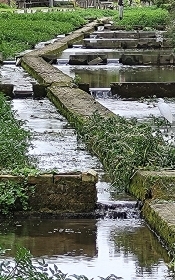Once watercress grew in the flowing waters of a stream in Oxfordshire
BITTER TASTING, WATERCRESS is a member of the cabbage family (Brassicaceae). It is rich in health-giving nutrients. In Britain, it is grown in fast flowing chalk streams. It used to be grown in streams on Hampstead Heath, and there is a row of cottages that formerly housed watercress workers on Hampstead’s Willow Road. Another place where it was once grown is the Oxfordshire village of Ewelme.
A trout stream runs past Ewelme. It was here in the late 19th century that the Smith family from the village of South Weston, not far from Ewelme and the larger town of Watlington, began cultivating watercress in the stream. The watercress beds stretch for about ¾ mile along the stream, and have now been preserved as a nature reserve. By the beginning of the 20th century, the watercress beds at Ewelme were flourishing, producing large crops. Hampers containing 56 lb of watercress were carried by wagon to Watlington railway station, and from there they were transported by train to the Midlands and Manchester. The cress from Ewelme was highly regarded all over the country.

The Smith family kept the watercress beds going until the mid-1960s, when they were sold to new owners. The beds were kept going but became increasingly less viable economically. They were closed in 1988. However, visitors to Ewelme can see the two rows of rectangular beds, each enclosed by low partitions. A boardwalk runs along the length of the beds, separating the two rows. The stream flows through the beds. What can be seen now was the result of much restoration work carried out by local volunteers. A small visitors’ centre stands next to the beds. Near the beds, there is a house called Watercress Cottages, where a member of the Smith family used to live.
Ewelme is an attractive village with many historic buildings. A visit to the watercress beds, now the home of waterfowl, is an unusual experience and well worth making.



